Abstract
The receptor alterations involved in catecholamine-induced desensitization of adenylate cyclase in human neutrophils have been investigated as has the ability of hydrocortisone to modify such alterations. Incubation of human neutrophils with isoproterenol for 3 h in vitro resulted in an 86% reduction in the ability of isoproterenol to stimulate cyclic AMP accumulation in the cells. Two types of receptor alterations were documented. There was a 40% reduction in the number of beta adrenergic receptors (42 vs. 25 fmol/mg protein, P < 0.005) present after desensitization as assessed by [3H]dihydroalprenolol ([3H]DHA) binding. In addition the receptors appeared to be relatively uncoupled from adenylate cyclase. This uncoupling was assessed by examining the ability of the agonist isoproterenol to stabilize a high-affinity form of the receptor, detected by computer modelling of competition curves for [3H]DHA binding. Desensitized receptors were characterized by rightward-shifted agonist competition curves. When hydrocortisone was added to the desensitizing incubations (combined treatment) there was a statistically significant attenuation in the desensitization process as assessed by the ability of isoproterenol to increase cyclic AMP levels in the cells. Although combined treatment did not prevent the decline in receptor number, it did attenuate the uncoupling of the receptors. Combined treatment resulted in competition curves intermediate between the control and the rightward-shifted desensitization curves. Prednisolone was similar to hydrocortisone in attenuating isoproterenol-induced uncoupling. Thus, steroids appeared to attenuate agonist-induced desensitization of the beta adrenergic receptor-adenylate cyclase system by dampening the ability of agonists to uncouple receptors without modifying their ability to promote down-regulation of beta adrenergic receptors.
Full text
PDF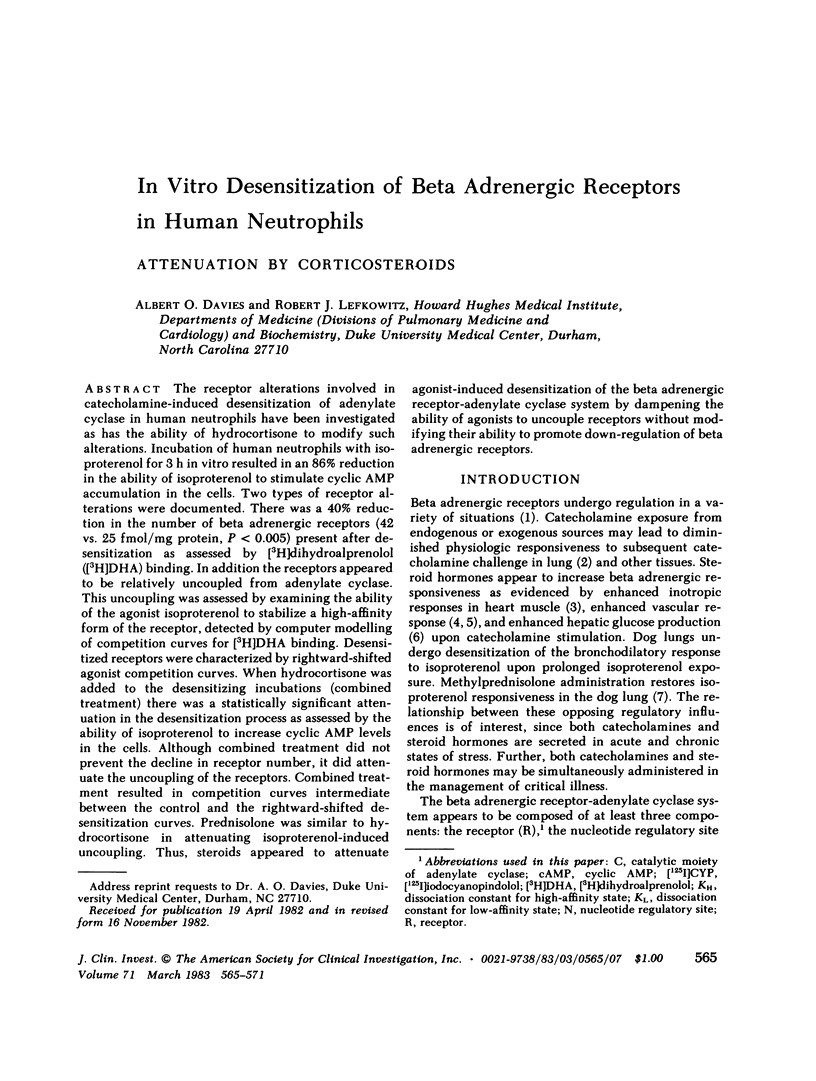
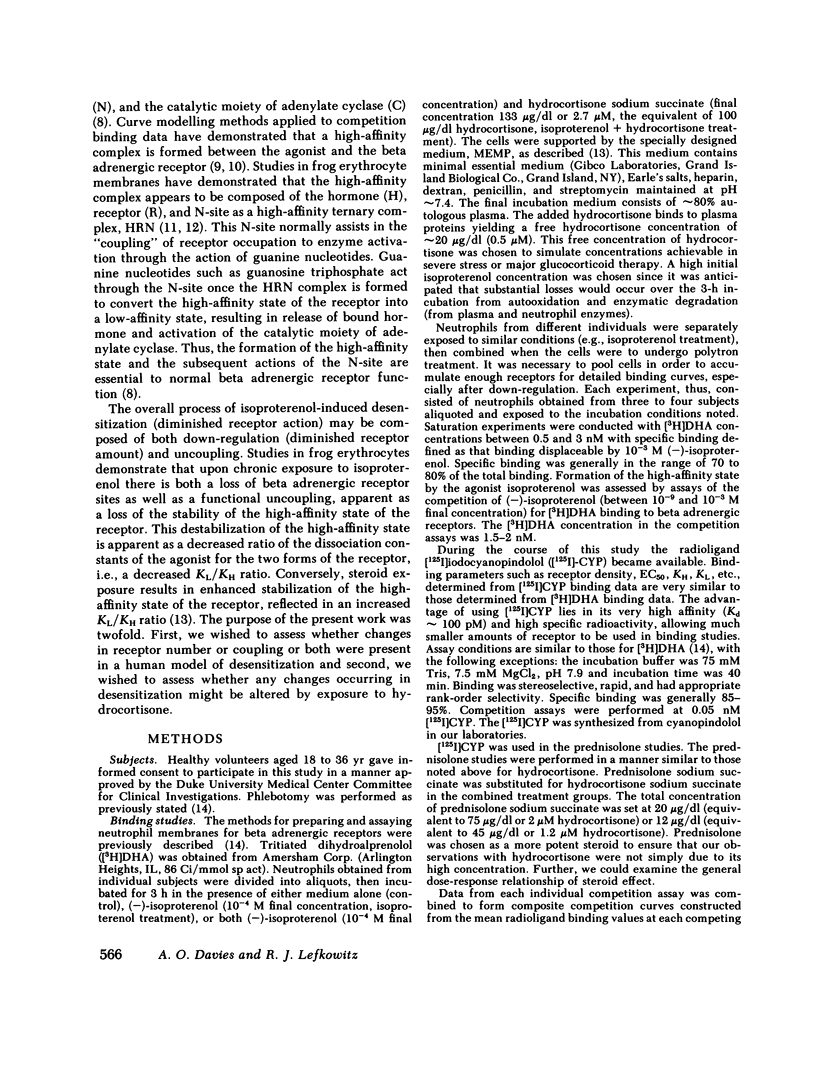
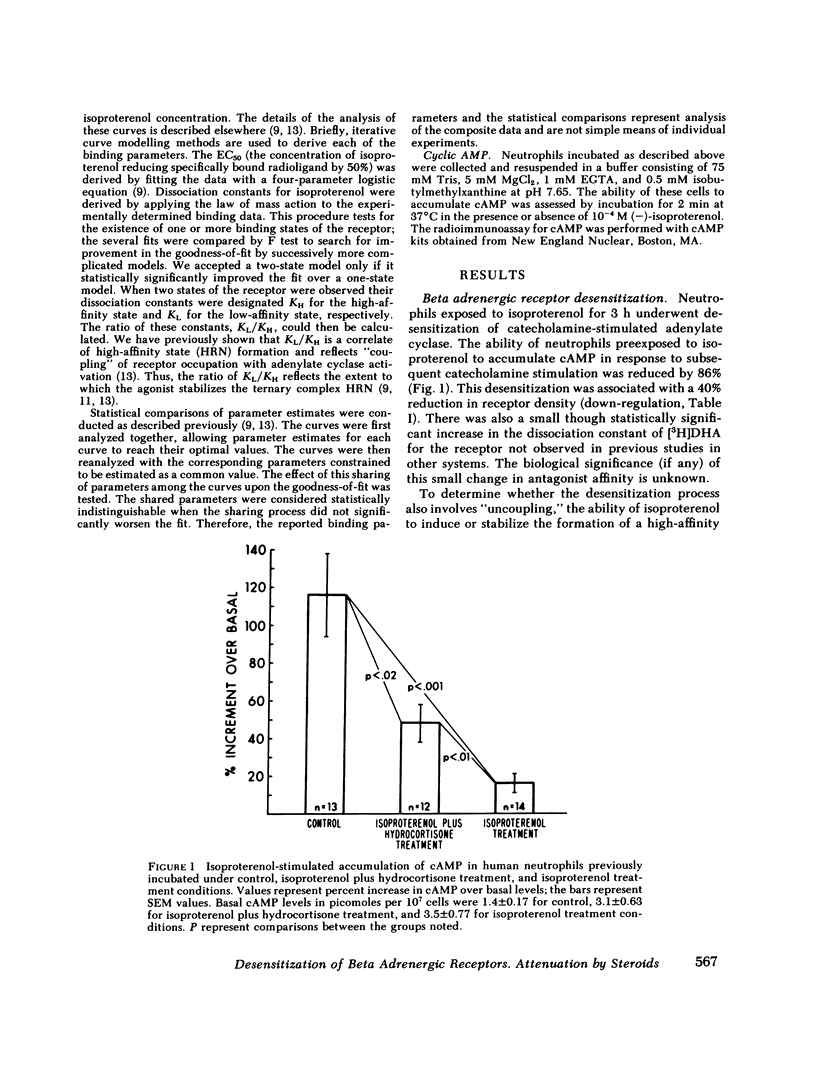
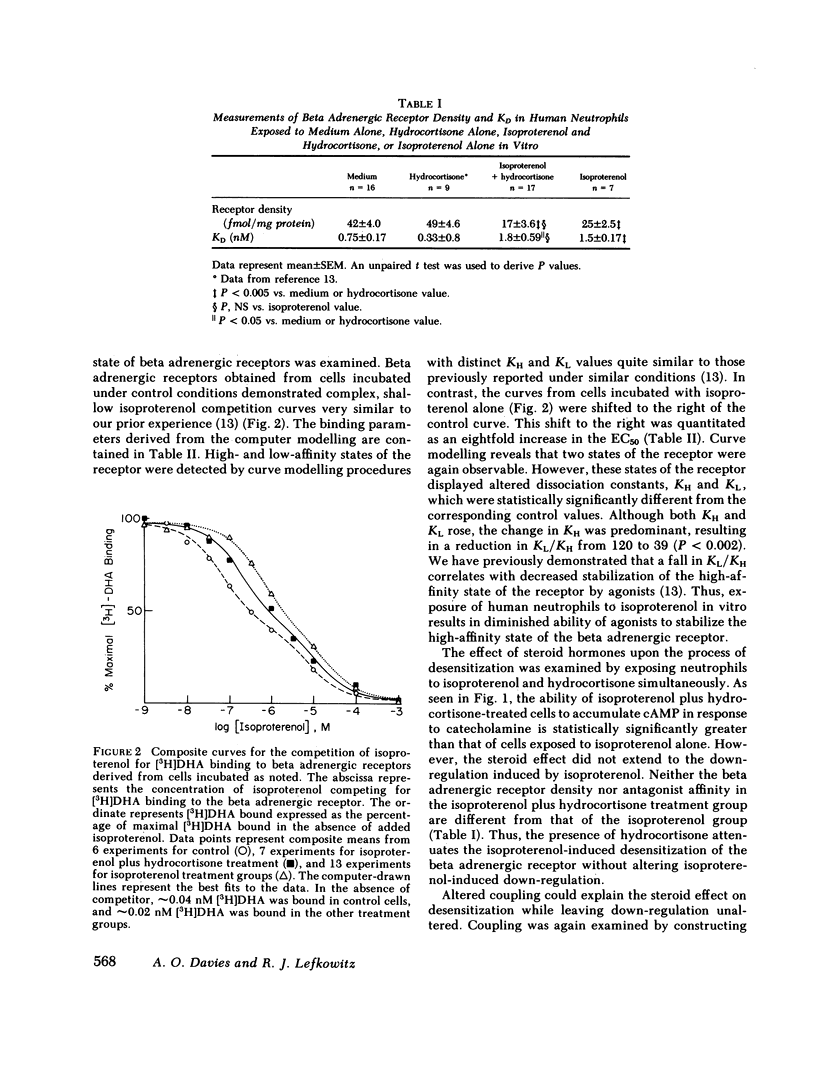
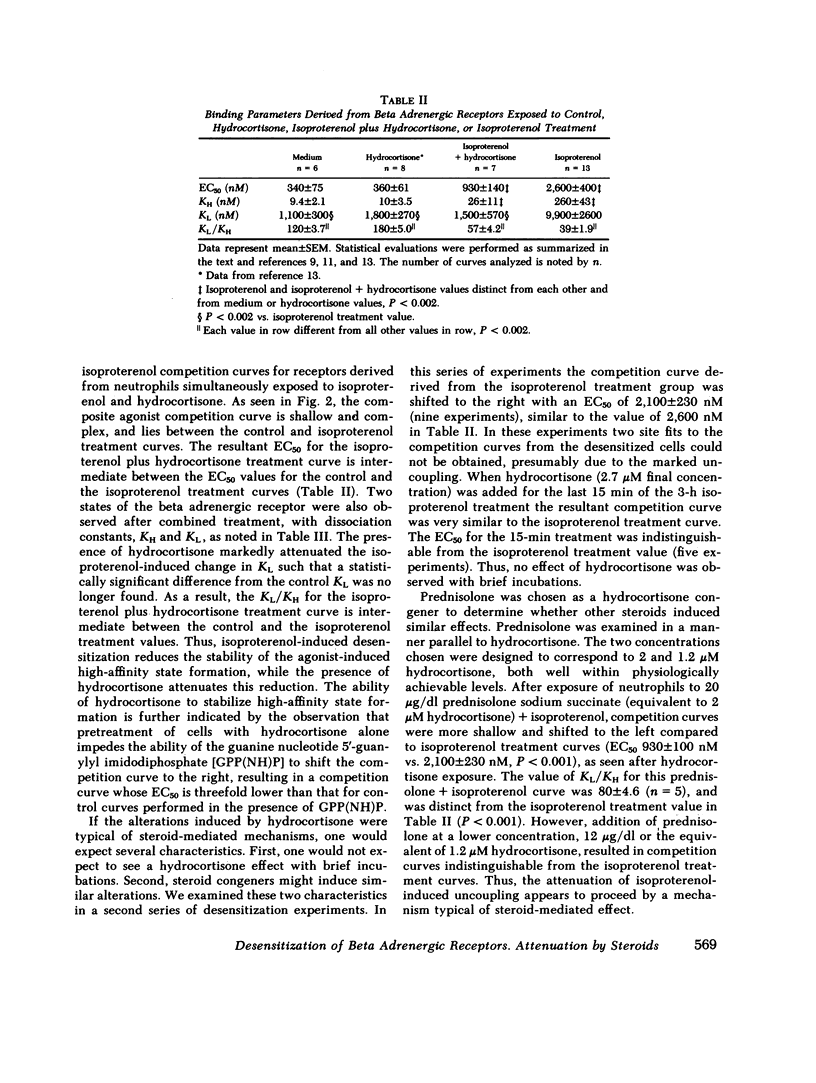
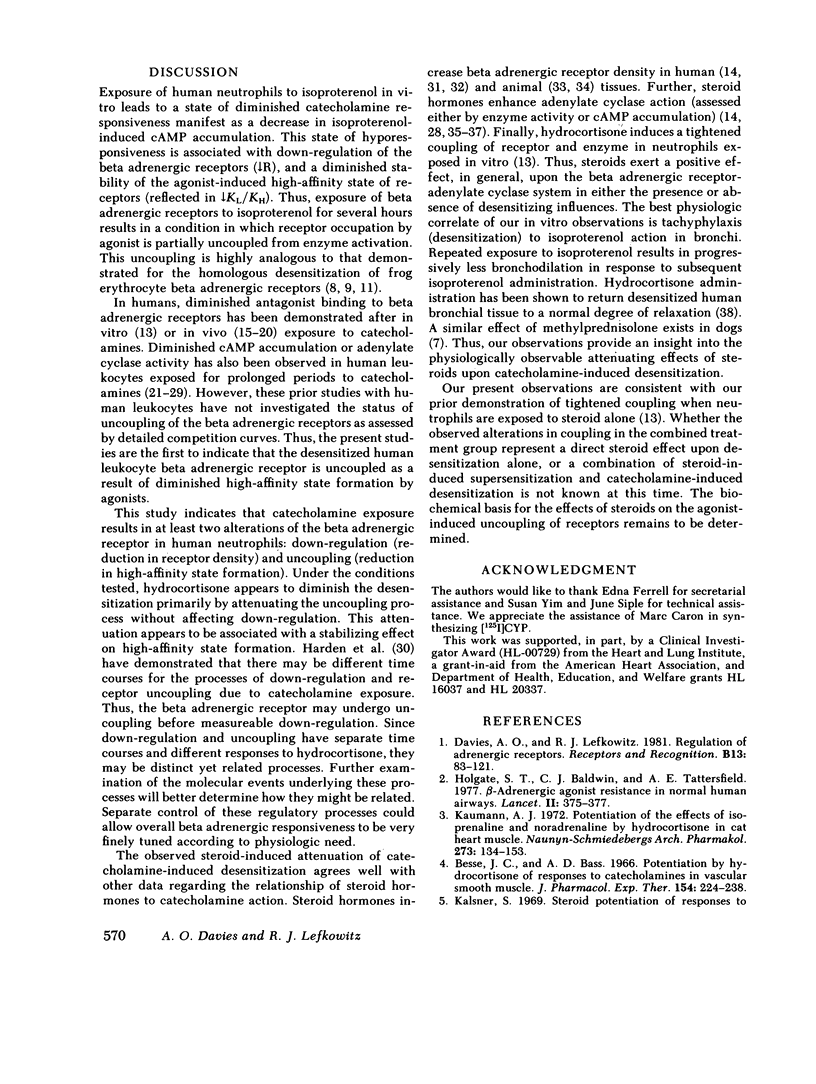
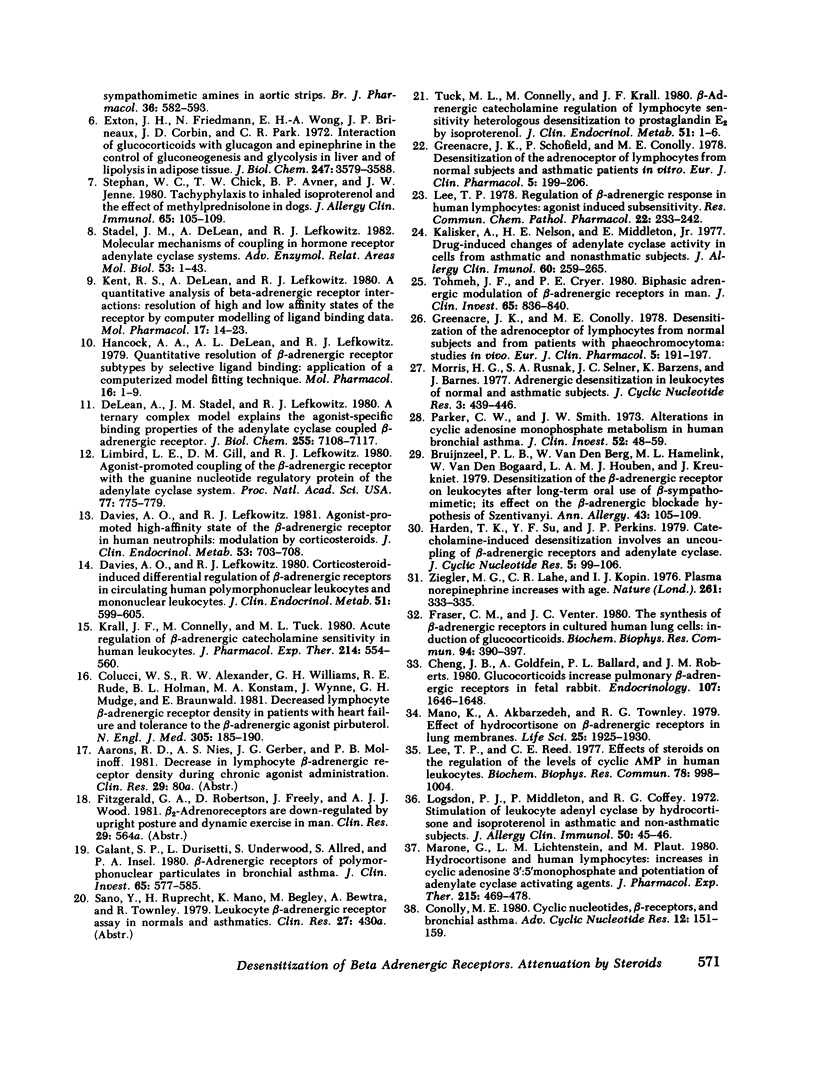
Selected References
These references are in PubMed. This may not be the complete list of references from this article.
- Besse J. C., Bass A. D. Potentiation by hydrocortisone of responses to catecholamines in vascular smooth muscle. J Pharmacol Exp Ther. 1966 Nov;154(2):224–238. [PubMed] [Google Scholar]
- Bruijnzeel P. L., van den Berg W., Hamelink M. L., van den Bogaard W., Houben L. A., Kreukniet J. Desensitization of the beta-adrenergic receptor on leucocytes after long-term oral use of a beta-sympathicomimetic; its effect on the beta-adrenergic blockade hypothesis of Szentivanyi. Ann Allergy. 1979 Aug;43(2):105–109. [PubMed] [Google Scholar]
- Cheng J. B., Goldfien A., Ballard P. L., Roberts J. M. Glucocorticoids increase pulmonary beta-adrenergic receptors in fetal rabbit. Endocrinology. 1980 Nov;107(5):1646–1648. doi: 10.1210/endo-107-5-1646. [DOI] [PubMed] [Google Scholar]
- Colucci W. S., Alexander R. W., Williams G. H., Rude R. E., Holman B. L., Konstam M. A., Wynne J., Mudge G. H., Jr, Braunwald E. Decreased lymphocyte beta-adrenergic-receptor density in patients with heart failure and tolerance to the beta-adrenergic agonist pirbuterol. N Engl J Med. 1981 Jul 23;305(4):185–190. doi: 10.1056/NEJM198107233050402. [DOI] [PubMed] [Google Scholar]
- Conolly M. E. Cyclic nucleotides, beta receptors, and bronchial asthma. Adv Cyclic Nucleotide Res. 1980;12:151–159. [PubMed] [Google Scholar]
- Davies A. O., Lefkowitz R. J. Agonist-promoted high affinity state of the beta-adrenergic receptor in human neutrophils: modulation by corticosteroids. J Clin Endocrinol Metab. 1981 Oct;53(4):703–708. doi: 10.1210/jcem-53-4-703. [DOI] [PubMed] [Google Scholar]
- Davies A. O., Lefkowitz R. J. Corticosteroid-induced differential regulation of beta-adrenergic receptors in circulating human polymorphonuclear leukocytes and mononuclear leukocytes. J Clin Endocrinol Metab. 1980 Sep;51(3):599–605. doi: 10.1210/jcem-51-3-599. [DOI] [PubMed] [Google Scholar]
- De Lean A., Stadel J. M., Lefkowitz R. J. A ternary complex model explains the agonist-specific binding properties of the adenylate cyclase-coupled beta-adrenergic receptor. J Biol Chem. 1980 Aug 10;255(15):7108–7117. [PubMed] [Google Scholar]
- Exton J. H., Friedmann N., Wong E. H., Brineaux J. P., Corbin J. D., Park C. R. Interaction of glucocorticoids with glucagon and epinephrine in the control of gluconeogenesis and glycogenolysis in liver and of lipolysis in adipose tissue. J Biol Chem. 1972 Jun 10;247(11):3579–3588. [PubMed] [Google Scholar]
- Fraser C. M., Venter J. C. The synthesis of beta-adrenergic receptors in cultured human lung cells: induction by glucocorticoids. Biochem Biophys Res Commun. 1980 May 14;94(1):390–397. doi: 10.1016/s0006-291x(80)80233-6. [DOI] [PubMed] [Google Scholar]
- Galant S. P., Duriseti L., Underwood S., Allred S., Insel P. A. Beta adrenergic receptors of polymorphonuclear particulates in bronchial asthma. J Clin Invest. 1980 Mar;65(3):577–585. doi: 10.1172/JCI109702. [DOI] [PMC free article] [PubMed] [Google Scholar]
- Greenacre J. K., Conolly M. E. Desensitization of the beta-adrenoceptor of lymphocytes from normal subjects and patients with phaeochromocytoma: studies in vivo. Br J Clin Pharmacol. 1978 Mar;5(3):191–197. doi: 10.1111/j.1365-2125.1978.tb01623.x. [DOI] [PMC free article] [PubMed] [Google Scholar]
- Greenacre J. K., Schofield P., Conolly M. E. Desensitization of the beta-adrenoceptor of lymphocytes from normal subjects and asthmatic patients in vitro. Br J Clin Pharmacol. 1978 Mar;5(3):199–206. doi: 10.1111/j.1365-2125.1978.tb01624.x. [DOI] [PMC free article] [PubMed] [Google Scholar]
- Hancock A. A., DeLean A. L., Lefkowitz R. J. Quantitative resolution of beta-adrenergic receptor subtypes by selective ligand binding: application of a computerized model fitting technique. Mol Pharmacol. 1979 Jul;16(1):1–9. [PubMed] [Google Scholar]
- Harden T. K., Su Y. F., Perkins J. P. Catecholamine-induced desensitization involves an uncoupling of beta-adrenergic receptors and adenylate cyclase. J Cyclic Nucleotide Res. 1979;5(2):99–106. [PubMed] [Google Scholar]
- Holgate S. T., Baldwin C. J., Tattersfield A. E. beta-adrenergic agonist resistance in normal human airways. Lancet. 1977 Aug 20;2(8034):375–377. doi: 10.1016/s0140-6736(77)90304-x. [DOI] [PubMed] [Google Scholar]
- Kalisker A., Nelson H. E., Middleton E., Jr Drug-induced changes of adenylate cyclase activity in cells from asthmatic and nonasthmatic subjects. J Allergy Clin Immunol. 1977 Oct;60(4):259–265. doi: 10.1016/0091-6749(77)90141-5. [DOI] [PubMed] [Google Scholar]
- Kalsner S. Steroid potentiation of responses to sympathomimetic amines in aortic strips. Br J Pharmacol. 1969 Jul;36(3):582–593. doi: 10.1111/j.1476-5381.1969.tb08013.x. [DOI] [PMC free article] [PubMed] [Google Scholar]
- Kaumann A. J. Potentiation of the effects of isoprenaline and noradrenaline by hydrocortisone in cat heart muscle. Naunyn Schmiedebergs Arch Pharmacol. 1972;273(1):134–153. doi: 10.1007/BF00508086. [DOI] [PubMed] [Google Scholar]
- Kent R. S., De Lean A., Lefkowitz R. J. A quantitative analysis of beta-adrenergic receptor interactions: resolution of high and low affinity states of the receptor by computer modeling of ligand binding data. Mol Pharmacol. 1980 Jan;17(1):14–23. [PubMed] [Google Scholar]
- Krall J. F., Connelly M., Tuck M. L. Acute regulation of beta adrenergic catecholamine sensitivity in human lymphocytes. J Pharmacol Exp Ther. 1980 Sep;214(3):554–560. [PubMed] [Google Scholar]
- Lee T. P., Reed C. E. Effects of steroids on the regulation of the levels of cyclic AMP in human lymphocytes. Biochem Biophys Res Commun. 1977 Oct 10;78(3):998–1004. doi: 10.1016/0006-291x(77)90520-4. [DOI] [PubMed] [Google Scholar]
- Lee T. P. Regulation of beta-adrenergic response in human lymphocytes: agonist induced subsensitivity. Res Commun Chem Pathol Pharmacol. 1978 Nov;22(2):233–242. [PubMed] [Google Scholar]
- Limbird L. E., Gill D. M., Lefkowitz R. J. Agonist-promoted coupling of the beta-adrenergic receptor with the guanine nucleotide regulatory protein of the adenylate cyclase system. Proc Natl Acad Sci U S A. 1980 Feb;77(2):775–779. doi: 10.1073/pnas.77.2.775. [DOI] [PMC free article] [PubMed] [Google Scholar]
- Logsdon P. J., Middleton E., Jr, Coffey R. G. Stimulation of leukocyte adenyl cyclase by hydrocortisone and isoproterenol in asthmatic and nonasthmatic subjects. J Allergy Clin Immunol. 1972 Jul;50(1):45–56. doi: 10.1016/0091-6749(72)90078-4. [DOI] [PubMed] [Google Scholar]
- Mano K., Akbarzadeh A., Townley R. G. Effect of hydrocortisone on beta-adrenergic receptors in lung membranes. Life Sci. 1979 Nov 26;25(22):1925–1930. doi: 10.1016/0024-3205(79)90614-3. [DOI] [PubMed] [Google Scholar]
- Marone G., Lichtenstein L. M., Plaut M. Hydrocortisone and human lymphocytes: increases in cyclic adenosine 3':5'-monophosphate and potentiation of adenylate cyclase-activating agents. J Pharmacol Exp Ther. 1980 Nov;215(2):469–478. [PubMed] [Google Scholar]
- Morris H. G., Rusnak S. A., Selner J. C., Barzens K., Barnes J. Adrenergic desensitization in leukocytes of normal and asthmatic subjects. J Cyclic Nucleotide Res. 1977 Dec;3(6):439–446. [PubMed] [Google Scholar]
- Parker C. W., Smith J. W. Alterations in cyclic adenosine monophosphate metabolism in human bronchial asthma. I. Leukocyte responsiveness to -adrenergic agents. J Clin Invest. 1973 Jan;52(1):48–59. doi: 10.1172/JCI107173. [DOI] [PMC free article] [PubMed] [Google Scholar]
- Stadel J. M., De Lean A., Lefkowitz R. J. Molecular mechanisms of coupling in hormone receptor-adenylate cyclase systems. Adv Enzymol Relat Areas Mol Biol. 1982;53:1–43. doi: 10.1002/9780470122983.ch1. [DOI] [PubMed] [Google Scholar]
- Stephan W. C., Chick T. W., Avner B. P., Jenne J. W. Tachyphylaxis to inhaled isoproterenol and the effect of methylprednisolone in dogs. J Allergy Clin Immunol. 1980 Feb;65(2):105–109. doi: 10.1016/0091-6749(80)90193-1. [DOI] [PubMed] [Google Scholar]
- Tohmeh J. F., Cryer P. E. Biphasic adrenergic modulation of beta-adrenergic receptors in man. Agonist-induced early increment and late decrement in beta-adrenergic receptor number. J Clin Invest. 1980 Apr;65(4):836–840. doi: 10.1172/JCI109735. [DOI] [PMC free article] [PubMed] [Google Scholar]
- Ziegler M. G., Lake C. R., Kopin I. J. Plasma noradrenaline increases with age. Nature. 1976 May 27;261(5558):333–335. doi: 10.1038/261333a0. [DOI] [PubMed] [Google Scholar]


